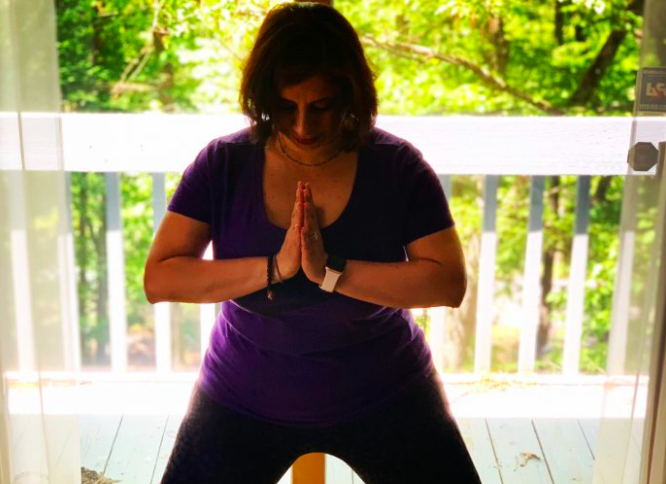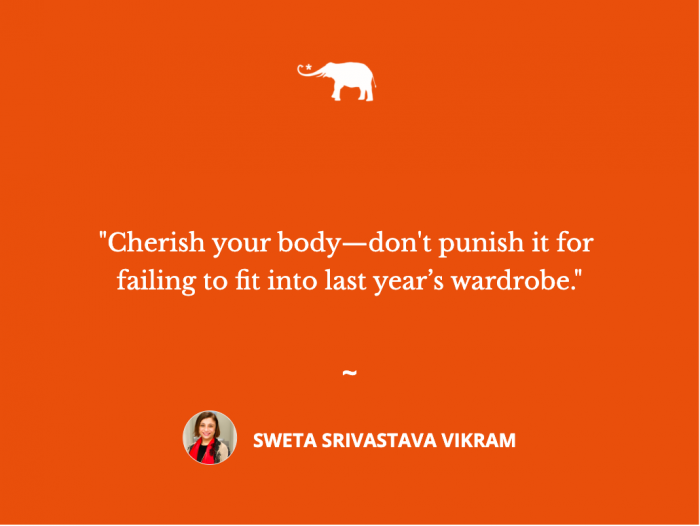For most of my life, I have been extremely active.
I like how movement makes me feel. It’s not about being a certain media-approved size (I have found solace in my South Asian pear-shaped body) or looking attractive for others.
I love how centered and strong I feel after a good workout. It impacts my mood, productivity, and quality of relationships. A good cardio or strength training or yoga session melts away my stress. It’s not a surprise that I continued going to my weight training studio, gym, and yoga center regularly until New York City went on pause last year, which was March 14, 2020.
Then the world changed. New York City became the epicenter of the Coronavirus in the United States. Inability to buy groceries became a real struggle. We didn’t know if breathing would make us sick. People I knew were in the hospital, fighting for their breath. Uncertainty and insecurity impregnated the air. No social interaction, no outlet for stress, no access to spaces to exercise, no hugging, and no certainty if you’d have a job when you woke up the next morning.
The pandemic made us more sedentary. We found ourselves “stuck” at home. The constant guilt of “Can I complain if I have a job, food, and roof over my head?” nudged so many of us even though we were still struggling. Humankind had to go from planning the future to living in the moment under the capsule of fear. To cope, we all unearthed an addiction.
The normal routine of hustle-bustle was replaced with remote working and virtual learning, overnight. Shirts turned to tees and evenings became about cruising through Netflix. Some found wine, others found comfort in food, and many relied on online shopping to navigate the difficult times. My Achilles’ heel became over-exercising.
Now that I wasn’t commuting to work or spending any travel time on my workouts, I had a few extra hours in a day. As an extrovert who was summoned to a life of solitary confinement because of the global spread of the virus, I found excuses to get out of the apartment to move out of the stress. Daily, I hiked five miles, did 60-90 minutes of yoga, and then some weight training at home.
Despite all the exercise, I didn’t lose weight. If anything, I gained a few pounds. Like many others, I did get outside and worked out more with utmost dedication. But every movement was curated. The natural state of living in New York City is to be rushing constantly. You are running to catch the subway, running between meetings, running to get to events, running errands—you get my drift. But the planned movement meant I was burning fewer calories. And then there were desserts.
We are languishing, as Adam Grant wrote recently, living in “the void between depression and flourishing—the absence of well-being.” Prior to the pandemic, we ate desserts occasionally. The diet of bad news and living in fear somehow gave me permission to turn weekend treats into daily sweet indulgences. The intentional exercise just brought me back to my normal caloric expenditure in the “pre-pandemic” days.
Also, while I was mindful of moving, I knew there was no socializing (aside from the bubble pod who mostly saw me in yoga clothes), weddings, celebrations, graduations, visiting museums or Broadway, holiday gatherings, beach vacations on the horizon. A part of me let go and filed pecan pie, brownies, and chocolate cake under “mental health necessities.”
Now with the western world reopening so suddenly, many of us probably feel unprepared. Jokes and over-circulated memes about “Quarantine-19 or Corona-20” became real and relatable overnight. You are expected to live your life again, which is great! But it doesn’t feel amazing when you have to think of a new wardrobe. I know a few people who have developed agoraphobia. Some have gotten comfortable being at home and working in their pj’s; others feel self-conscious of their weight gain and are not ready for others to see their body.
When I returned to my gym a few weeks ago, my ego was shred to pieces. In the old days, I was lifting 90 pounds without a struggle. My stamina and endurance were at an all-time high. I was preparing my body for the Spartan Race. Despite all my workouts during the pandemic, my body changed. My first week back in the gym, I could barely lift two pounds. But in just two weeks, I started to lift eight pounds. Instead of panting between sets, I found the endurance to exercise with ease for 60 minutes.
These numbers might seem arbitrary, but I share them so you can understand that the human body is a piece of art. You take care of it, and it shows. Your mind might taunt you or remind you of your incapability, but you are more than your mind’s definition.
Every time that the inner voice starts to criticize any part of me that’s not as optimal as the “old days,” I whisper, “I am not my mind.” I remind myself that after everything we’ve endured this past year, I am grateful to be breathing and standing in a gym while friends and family in Asia are battling the virus and juggling life in a lockdown. These legs and arms and each organ carried us through the pandemic.
Cherish your body—don’t punish it for failing to fit into last year’s wardrobe.
Don’t allow your mind to tell you that you don’t look good. Or those 15 extra pounds is why someone won’t ask you out on a date. We are still healing, grieving, and reeling from the effects of the pandemic. You don’t need additional stress.
Reset your lifestyle slowly. Go for your walks, workouts, and eat what nourishes your body. While it’s important to take care of your health—this also includes your emotional and mental health—it’s also important to acknowledge that last year wasn’t normal.
Human interaction and safely socializing with our loved ones will do us more good than some random diet or self-loathing. Pay attention to the triggers. Be around those who uplift you and motivate you to take charge of your life, not those who make you feel small (no pun intended) because you are feeling larger than the pre-pandemic days.
“If you don’t control your mind, someone else will.” ~ John Allston
~












Read 12 comments and reply